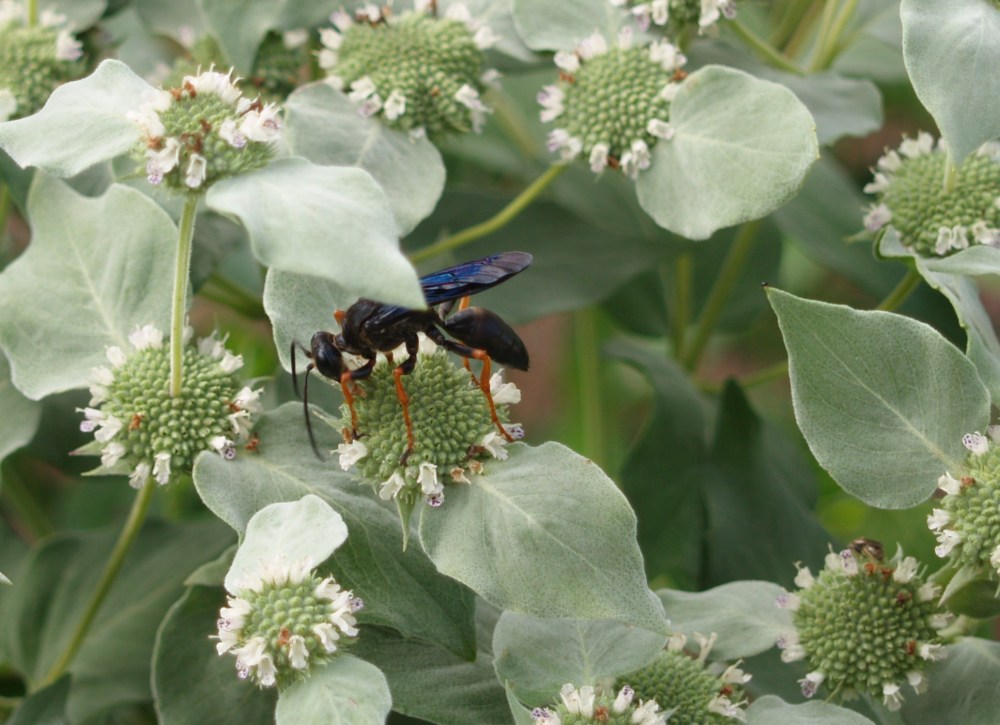For years I’ve made a habit of poking my nose and camera within inches of flowers as butterflies and bees buzzed about, and until a few weeks ago I had not been stung in a great while. Then, wasps that were nesting between boulders bordering one of the garden’s ponds got me several times before I could leap to safety. Later in the day bees of some sort took offense when I ventured too near a Russian sage to transplant a foxglove. As I scurried away I was too rushed to identify my assailants, except that they were small, flying, and had stingers.
Most often I have the good sense to steer clear of wasps (above), but obviously not always. There is a sizable nest in the upper limbs of a Chinese Snowball viburnum outside the library window, and after the recent attack I’ve exercised extreme caution in wandering on the path beneath it so that they’re not provoked.
In recent years there has been a noticeable lack of honey bees, and of course there is considerable concern about their recent decline. Their numbers seem greatly increased in the garden this summer, perhaps because I planted several mountain mints (Pycnanthemum virginianum) and a hummingbird mint (Agastache, above) in late summer of last year. In bloom the shrub-like perennials nearly vibrate with many dozens of bees buzzing about (below), and I’m cautious not to disturb them more than is necessary.
Bumblebees (below), butterflies, and an assortment of moths are abundant in the garden, and they seem only mildly annoyed by my presence. If I become too bothersome bumblebees will drift off to another bloom, and butterflies and moths are skittish and flee quickly.
The butterflies (below) and bees have become as much an ornament of the garden as the blooms that they visit. I cannot imagine the garden without them, and for this reason I tolerate the modest numbers of Japanese beetles and aphids. 
I only discovered this blog a week ago, while dreaming of and searching for swimming ponds. I like to think that our lot looks like yours might have twenty years ago, and it gives me some hope and patience with myself. (Young children still at home and all.) However. If you post one more shot of that gorgeous passion flower vine, you’re going to lead this zone 4 gardener to covet! Thanks for sharing your gardens with us!
There are many tropical passion vines that grow vigorously so that you’ll get your money’s worth in a short season. I haven’t needed to keep one through the winter indoors, but many tropicals can easily be kept in a sunny room, or cut back and kept dry to survive the winter inside.
When I look at photos of the garden twenty two years ago I barely remember that there wasn’t anything here except the wooded border. For a moment it doesn’t seem so long ago, and then reality sets in, and I recall that I’m not so young as I once was, and neither is the garden.
🙂 Our next house project is to enclose the screened porch for that very purpose. We had a solid six months of winter this year in Minnesota, and the thought of a room dedicated to housing all those not-hardy plants, even with mountains of snow outside the door, makes me giggle.
Sadly, our yard is more solid woods (maples) than wooded border, and with a fairly steep hill in back (and accompanying erosion, deep shade, clay soil…), I’ve been grappling with the water issues you mentioned in your last post. I’m not sure how far the gardens will extend, but I already get the same soul-satisfying contentment from my lot that I read in your writings.
Do ladybugs live this far south? They did the trick on our aphid problem in CT. Nomnomnom! Bugs are gone.
There are times when I have no problems with aphids at all, and other times when they seem out of control. Once, I sprayed an insecticidal soap to save a dwarf crapemyrtle, but otherwise the plants have struggled through on their own with no ill effects the next year. I’m sure the ladybugs eat their share, but aphids get out of hand quite quickly.
We have many, many dragonflys around our yard and evergreen bushes this summer. Any reason why so many?
I have noticed more dragonflies darting around my ponds this year. I suspect that the wet spring contributed to this because their nymphs are aquatic, like mosquitoes.
Hi Dave:
Last summer I got stung twice by yellow jackets on the bike trail. So many times over the years I now have to carry an Epi Pen as my knee swelled up to the size of a small football. I too have bees and wasps around my gardens and try to steer clear. Sometimes it works. Recently I just learned of a product called the Waspinator – a fake hornet’s nest that scares off other stingers within about 200 feet. I know some nurseries carry them. Might Meadow’s consider carrying them too? Thanks for all the great ideas and plants!